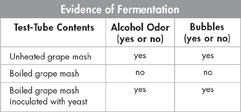Standardized Test Prep
Multiple Choice
All of the following are characteristics of some protists EXCEPT
peptidoglycan in the cell walls.
a membrane-bound nucleus.
flagella.
cilia.
The structures in Amoeba that help the organism move and feed are the
flagella.
cilia.
food vacuoles.
pseudopods.
In protists, the process of conjugation
is linked to photosynthesis.
results in an exchange of some genetic material.
produces offspring that are genetically identical to the parent.
decreases the genetic diversity of a population.
Which of the following statements about slime molds is false?
Slime molds are eukaryotes.
Slime molds play an important part in recycling nutrients.
Slime molds are multicellular at some time during their life cycle.
Slime molds are photosynthetic protists.
Algal blooms can be caused by
paramecia.
lichens.
dinoflagellates.
Trichonympha.
Alternation of generations BEST describes sexual reproduction in
Paramecium.
water molds.
Amoeba.
yeast.
The primary carbohydrate found in the cell walls of fungi is
chitin.
actin.
cellulose.
starch.
Questions 8–10
Ripe grapes are covered with a grayish film, or bloom, that contains yeasts and sometimes other microorganisms. A group of students prepared three test tubes of fresh mashed grapes. They heated two of the test tubes to boiling and then cooled them. They inoculated one of those test tubes with live yeast, incubated all three test tubes at 30°C for 48 hours, and then examined the test tubes for signs of fermentation—an alcohol odor and bubbles. Their data are summarized in the table below.
What is the independent variable in the students' investigation?
the presence of live yeast
an odor of alcohol
bubbles
time
What is the dependent variable in the students' investigation?
time
boiling
an odor of alcohol and the presence of bubbles
the presence of live yeast
What can you conclude based on the students' results?
Uninoculated, boiled grape mash does not seem to ferment over a 48-hour period.
Boiled grape mash that contains live yeast undergoes fermentation.
Grape mash does not ferment unless live yeast is added.
Both A and B are correct.
Open-Ended Response
How does each of the partners in the lichen symbiosis benefit from the relationship?
| Question | 1 | 2 | 3 | 4 | 5 | 6 | 7 | 8 | 9 | 10 | 11 |
|---|---|---|---|---|---|---|---|---|---|---|---|
| See Lesson | 21.2 | 21.2 | 21.2 | 21.3 | 21.3 | 21.2 | 21.4 | 21.4 | 21.4 | 21.4 | 21.4 |
Table of Contents
- Formulas and Equations
- Applying Formulas and Equations
- Mean, Median, and Mode
- Estimation
- Using Measurements in Calculations
- Effects of Measurement Errors
- Accuracy
- Precision
- Comparing Accuracy and Precision
- Significant Figures
- Calculating With Significant Figures
- Scientific Notation
- Calculating With Scientific Notation
- Dimensional Analysis
- Applying Dimensional Analysis





